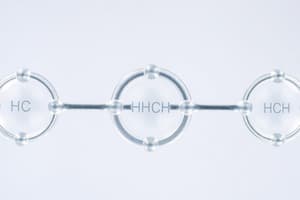Podcast
Questions and Answers
What is the main reason why atoms form chemical bonds?
What is the main reason why atoms form chemical bonds?
Atoms form chemical bonds to achieve a stable electron configuration, often resembling the electron configuration of a noble gas.
Explain how a chlorine atom forms a chloride ion.
Explain how a chlorine atom forms a chloride ion.
A chlorine atom gains one electron to achieve a full octet, forming a chloride ion (Cl-) with a negative charge.
Why are metals in groups 1 and 2 considered the most reactive metals?
Why are metals in groups 1 and 2 considered the most reactive metals?
Metals in groups 1 and 2 have only one or two valence electrons, respectively, easily lost to form cations and achieve a stable configuration.
Describe the electron configuration characteristic of elements in group 17 (halogens).
Describe the electron configuration characteristic of elements in group 17 (halogens).
Explain the difference between a cation and an anion.
Explain the difference between a cation and an anion.
Explain why atoms of noble gases are generally unreactive.
Explain why atoms of noble gases are generally unreactive.
How does a positive ion (cation) form?
How does a positive ion (cation) form?
What is the octet rule and how does it relate to chemical bonding?
What is the octet rule and how does it relate to chemical bonding?
Describe how elements form compounds.
Describe how elements form compounds.
Explain what electron affinity and ionization energy are and how they relate to reactivity.
Explain what electron affinity and ionization energy are and how they relate to reactivity.
Why are metals generally more reactive than nonmetals?
Why are metals generally more reactive than nonmetals?
What is the difference between a cation and an anion?
What is the difference between a cation and an anion?
Describe the electron configuration of an atom after it has formed a pseudo-noble gas configuration.
Describe the electron configuration of an atom after it has formed a pseudo-noble gas configuration.
Flashcards
Chemical Bond
Chemical Bond
The force that holds two atoms together.
Octet Rule
Octet Rule
Atoms try to achieve eight valence electrons for stability.
Anions vs Cations
Anions vs Cations
Anions are negatively charged ions; cations are positively charged ions.
Reactivity of Metals
Reactivity of Metals
Signup and view all the flashcards
Group 17 Elements
Group 17 Elements
Signup and view all the flashcards
Valence Electrons
Valence Electrons
Signup and view all the flashcards
Cation
Cation
Signup and view all the flashcards
Anion
Anion
Signup and view all the flashcards
Ionization Energy
Ionization Energy
Signup and view all the flashcards
Electron Affinity
Electron Affinity
Signup and view all the flashcards
Noble Gas
Noble Gas
Signup and view all the flashcards
Study Notes
Ion Formation
- Elements form compounds to achieve a stable electron configuration. This often involves gaining, losing, or sharing electrons.
- A chemical bond is the force holding two atoms together. Attraction between positive nuclei and negative electrons, or between positive and negative ions, creates bonds.
- The octet rule dictates that atoms tend to gain, lose, or share electrons to achieve eight valence electrons, similar to the electron configuration of noble gases.
- Noble gases have high ionization energies and low electron affinities, indicating their stability and lack of chemical reactivity. Noble gases have a full outermost energy level.
- Elements react to acquire the stable configuration of a noble gas. Atoms obtain a stable arrangement of eight valence electrons in their outermost energy level by gaining or losing valence electrons.
- A positive ion (cation) forms when an atom loses one or more valence electrons to obtain a noble gas configuration. For example, a sodium atom becomes a sodium ion (Na+) by losing one electron.
- Metals are reactive due to their ability to readily lose valence electrons. Group 1 and 2 metals are the most reactive.
- Transition metals often form 2+ or 3+ ions; however, they can also form ions with larger positive charges. Other relatively stable electron arrangements are called "pseudo-noble".
- A negative ion (anion) forms when an atom gains one or more valence electrons to achieve a noble gas configuration. For example, chlorine gains one electron to become a chloride ion (Cl−).
- Nonmetals readily gain electrons to attain a stable outer electron configuration, forming anions.
- Ions formed by metals in groups 1, 2, and 13, and nonmetals in groups 15, 16, and 17 are summarized in tables.
Studying That Suits You
Use AI to generate personalized quizzes and flashcards to suit your learning preferences.




